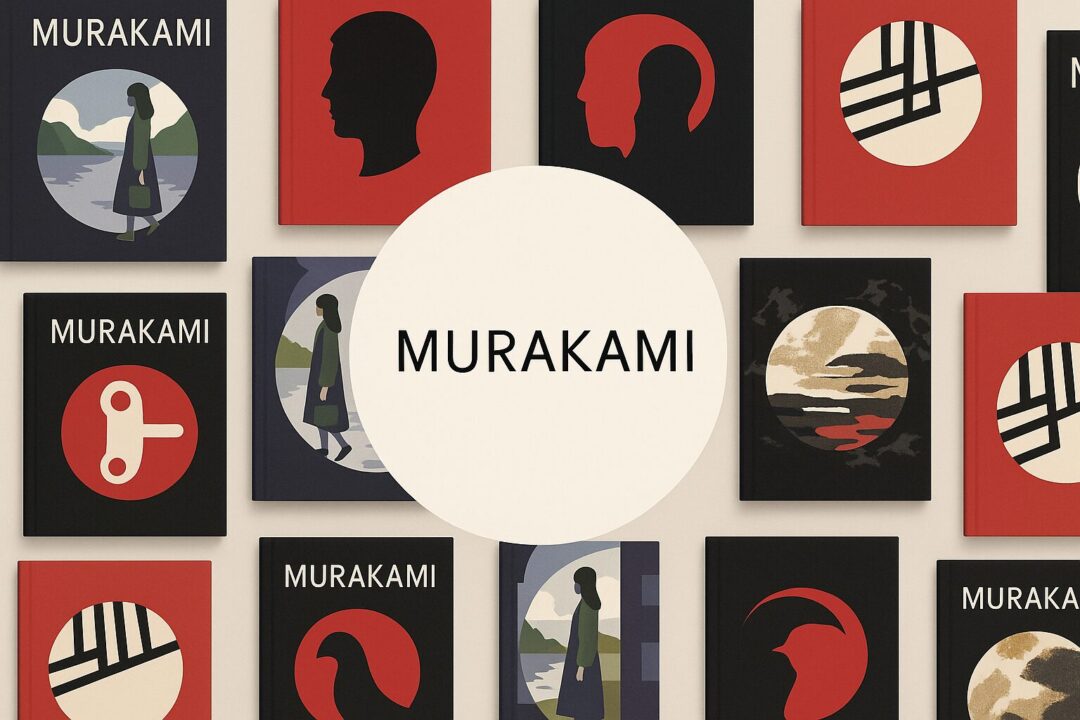Starting a Murakami book is like stepping into a world where the quest for identity intertwines with magical realism. His narratives weave human emotions with Japanese culture, from the surreal depths of “The Wind-Up Bird Chronicle” to the enigmatic tales in “Blind Willow,” “Sleeping Woman.”
Themes of history, memory, and the psyche emerge in works like “Killing Commendatore,” while his teaching at Tufts University reflects his literary impact. For those eager to explore his books, we have written a roundup of the best Marukami books that you should know about.
Top 12 Must-Read Murakami Novels
For those eager to delve into Murakami’s novels, this list represents the cream of the crop. Each book is a gateway to the extraordinary, blending the mundane with an essence that’s unmistakably Murakami.
Norwegian Wood – A Tale of Love and Loss
“Norwegian Wood”, often hailed as the best Murakami book, is a poignant narrative that resonates deeply with both Japanese students and readers worldwide.
It follows Toru Watanabe as he navigates the complexities of young love and grief, encapsulating the spirit of Japan and internationally acclaimed literature.
The novel’s magical realism underscores the emotional journey of its characters, making it a cornerstone of Murakami’s work. It’s a book that speaks to the heart, exploring themes that are universal and deeply personal at the same time.
The Wind-Up Bird Chronicle – A Journey Through the City and Its Uncertain Walls
In “The Wind-Up Bird Chronicle,” we follow Toru Okada through a labyrinth of awkward moments and memories lost and regained. This book stands out among Murakami novels for its intricate plot that deals with Japan’s dark shadows cast by World War II.
The elements of the Wind-Up Bird Chronicle blend history with the surreal, creating an unforgettable reading experience.
The novel’s strength lies in its ability to weave complex narratives with the everyday, pushing the reader to question the very fabric of reality. It’s a story that stays with you, long after the final page has been turned.
Kafka on the Shore – A Metaphysical Odyssey
With “Kafka on the Shore”, Murakami takes readers on a journey through realms that defy logic. The protagonist, Kafka Tamura, embarks on a quest that is as much about escaping a cursed prophecy as it is about finding oneself.
The novel’s use of magical realism allows for a storytelling that is both dreamlike and grounded in emotional truth.
This book is a testament to Murakami’s ability to blend the fantastic with the relatable, creating a metaphysical odyssey that challenges and rewards the reader in equal measure.
1Q84 – An Epic of Altered Realities
As a typical Murakami creation, “1Q84” presents an epic tale where the lives of a fitness instructor and a writer converge in a world with two moons. This novel stretches the boundaries of reality, questioning the nature of existence and the threads that connect us all.
Its complex narrative structure and richly detailed world make “1Q84” not just a novel but an experience, one that requires the reader’s full immersion and rewards it with a storyline that is as intellectually engaging as it is emotionally compelling.
Colorless Tsukuru Tazaki and His Years of Pilgrimage – The Quest for Identity
In “Colorless Tsukuru Tazaki,” Murakami explores a man’s journey to reconcile his past and forge his identity. This introspective novel delves into the protagonist’s psyche, examining the impact of friendships lost and the pain of feeling insignificant.
Through Tsukuru Tazaki’s pilgrimage, Murakami addresses the universal search for meaning and the struggle to find one’s place in the world. It’s a story that invites reflection and offers a window into the human soul.
A Wild Sheep Chase – In Pursuit of an Elusive Animal
A precursor to later works, “A Wild Sheep Chase” is a novel where the surreal meets the detective genre. This tale takes readers on a journey that is as bizarre as it is thrilling, following a trail that leads back to “Hear the Wind Sing” and “Pinball.”
The narrative weaves through a maze of unexpected twists, presenting a wild sheep chase that is both literal and metaphorical. It’s Murakami at his most whimsical, yet it remains grounded in a reality that is uniquely his own.
Dance Dance Dance – The Sequel that Explores Deeper Realms
Building on “A Wild Sheep Chase,” “Dance Dance Dance” delves deeper into the interconnectedness of our lives. With an ear model as one of the intriguing characters, this novel examines the tendency to commodify and sell everything, including human relationships.
This book stands among the best Murakami works for its ability to dance between the profound and the absurd, all the while maintaining a narrative that compels the reader to turn the page.
Hard-Boiled Wonderland and the End of the World – A Mind-Bending Narrative
Blending science fiction with the literary finesse seen in “Kafka on the Shore,” “Hard-Boiled Wonderland and the End of the World” presents a dual narrative that bends the mind as it warps the boundaries of reality.
The novel’s split world is a metaphor for the fragmented nature of our existence, and Murakami masterfully guides the reader through this fantastical landscape with the skill of a seasoned storyteller.
After Dark – Tokyo By Night
“After Dark” captures the essence of Tokyo by night through the eyes of a young woman. This novel is a dance between fantasy and reality, where the city’s heartbeat is felt through the myriad lives that intersect in the quiet hours before dawn.
The narrative pulls you into the nocturnal world, where the line between the real and the imagined blurs, and every character’s story becomes part of a larger, mesmerizing tapestry.
Sputnik Sweetheart – Longing and Disconnection
In “Sputnik Sweetheart,” Murakami crafts a detective story that’s more about the heart’s mysteries than crime-solving. This novel explores themes of longing and disconnection, as the characters seek something just beyond their reach—like a satellite orbiting alone in space.
The narrative’s emotional resonance is amplified by Murakami’s signature prose, making “Sputnik Sweetheart” a poignant read that lingers in the mind.
South of the Border, West of the Sun – Nostalgia and Regret
“South of the Border, West of the Sun” is a story of a jazz bar owner caught between his present and a past love. This novel encapsulates the essence of nostalgia and regret, painting a portrait of a man at the crossroads of life.
Murakami’s delicate handling of the protagonist’s inner turmoil makes this novel a deeply affecting read, capturing the complexities of the human heart with grace and honesty.
Hear the Wind Sing – The Novel that Started It All
As the first step into Murakami’s literary world, “Hear the Wind Sing” sets the stage for “A Wild Sheep Chase” and “Hard-Boiled Wonderland.” It introduces readers to the heart and soul of his narrative style, centered around a Chinese bartender and the protagonist’s contemplations on life.
This novel is a must-read for anyone who wishes to understand the roots of Murakami’s fiction, offering a glimpse into the beginnings of his remarkable career in literary fiction.
Murakami’s Short Stories and Their Significance
These stories offer bite-sized glimpses into his enchanting world, perfect for those looking to dip their toes into the Murakami experience:
The Elephant Vanishes – A Collection of Surreal Tales
In “The Elephant Vanishes,” Haruki Murakami transforms the ordinary into the extraordinary. Each surreal tale takes unexpected turns, drawing you into a dreamlike world.
Imagine waking up to a vanished elephant and becoming the detective on the case. These short stories offer a perfect Murakami fix, brimming with mystery and meaning.
Fans of Richard Brautigan or Kurt Vonnegut will find a similar charm in this collection, where every story lingers long after the last page.
Men Without Women – Intimate Portraits of Loneliness and Isolation
“Men Without Women” explores the solitude of men navigating life alone. Murakami offers intimate, reflective tales that reveal the depths of their hearts and minds.
Much like Dostoevsky’s introspective works, these stories invite you to examine your own experiences with loneliness and connection. More than just the absence of women, this collection delves into the human condition.
If you appreciate Fitzgerald’s explorations of the soul, “Men Without Women” is a must-read on your Murakami journey.
Conclusion: The Enduring Allure of Murakami’s Literary Works
Haruki Murakami’s novels are more than just books—they’re portals to worlds where the mundane and the mystical collide. Whether you’re drawn to the melancholic beauty of “Norwegian Wood”, the labyrinthine intrigue of “The Wind-Up Bird Chronicle”, or the surreal odyssey of “Kafka on the Shore”, his stories linger in the mind like half-remembered dreams. Murakami’s unique blend of existential wonder, quiet loneliness, and unexpected warmth has cemented his place as a literary icon, captivating readers across generations and cultures.
For newcomers, this guide offers a roadmap to his rich bibliography; for longtime fans, it’s a reminder of why his work remains unforgettable. If you’re looking to branch out beyond Murakami, you might enjoy exploring other best Japanese books that showcase the country’s literary brilliance, or dive into the world of Gege Akutami, the creator behind Jujutsu Kaisen. And for manga enthusiasts, our list of the best manga of all time offers even more ways to immerse yourself in Japanese storytelling.
So pick up “1Q84” or “Men Without Women”, settle into your favorite chair, and let the journey begin. The alleyways of Tokyo, the hum of jazz bars, and the whisper of hidden worlds await. Happy reading.




